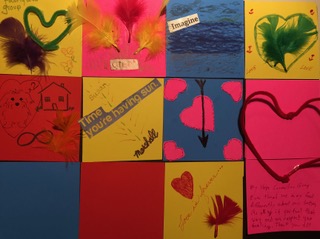We all have a strong inherent desire to belong, to connect to others. It feels good to be a part of a group, to feel accepted by others, to feel validated. For many of us, the death of a loved one can make you feel alone, isolated, different. When you lose a significant other, you may also lose your group, your unit, your sense of belonging. Rediscovering community can provide a tremendous sense of relief.
Art therapy is one way that you can rediscover your community — or even create a new community of people with a shared experience. Art therapy allows you to express your feelings by, for example, creating a quilt. During a recent spousal loss group held at Hope Connection, the members were asked to each create an individual paper quilt piece. They were to draw or write a symbol or a message to represent their significant other. Then the pieces were put together to make a community quilt, a symbol to represent each individual connecting, belonging and coming together as a group. The accompanying image is the wonderful quilt the members created.

There have been studies that show how these kinds of activities may affect adults in bereavement. Research shows that being in touch with physical materials and creating art are beneficial to adjusting to life changes, socialization and quality of life. In one study by Cathy Malchiodi, she writes, “art therapy with older adults often focuses on the current interests of participants, improvement of quality of life, assistance with the adjustment to life changes, and increasing socialization.” The research emphasizes how the older adult’s brain is still in a state of development, and engaging in activities, such as the arts, can be seen as not only positive stimulation, but as a multifaceted process working on implicit and explicit levels, allowing for beneficial coping and learning.
By coming together through creative art making, individuals found a way to work through the adverse situations they had experienced within the supportive and understanding context of a communal setting, when clinical models of healing were either non-existent, not available or not accessible. In a more current study on well-being for women, researchers Margaret Maidment and Jeanie Macfarlane discovered, from interviews conducted with women in a community arts and crafts group, that pursuing an interest in art making within a group setting allowed for women’s self-esteem to be supported and for community connectedness to occur.
As seen in the image, six out of nine members that participated in the community quilt created hearts. That was a symbol not only to represent their love for their significant other, but symbolic of the members coming together, connecting, bonding, belonging.
Quilting, within a group art therapy context, could be viewed as an effective therapeutic tool in promoting well-being. Donnell says, “The actual making of a quilt as a continuous piece of fabric addresses itself as a system of continuity… a bridge to all from whom we felt excessively separated.” In this statement, she expresses that this collectiveness and connection to others can be symbolically explored in the process of making a quilt, counteracting forms of social isolation.
Beyond creating artwork as a group, the simple act of belonging to a group can also provide a sense of connection, a sense of belonging. We each hold our individual stories, individual memories of our loved one, individual losses. When we come together as a group, though, we share our stories, our memories, with others, and those stories and memories live on through our connections — our new community.
Jessica Gardner, in a beautiful poem called Connected, explores the power of our connections to others.
You were lost. Forgotten.
Cut off, with no air to breathe.
Once you comforted.
You cared for.
Provided warmth and security.
To the bodies that left you on the ground.
Now, You are seen.
You are remembered.
I tend to you
I sense your touch.
I begin to see more of you
Stitch by stitch.
Stitch by Stitch
We come closer
And together, we give
Life. Growth. Warmth.
We may not be inviolable
But we are
And always will be
Connected.

